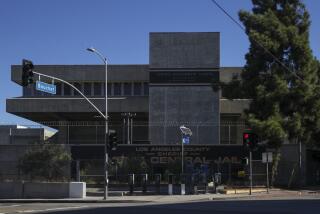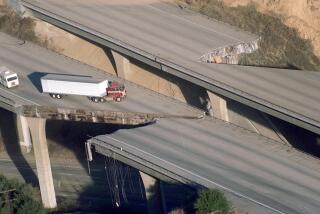Egor Popov; Seismic Safety Expert, Engineering Professor
- Share via
Egor Popov, pioneering UC Berkeley professor of structural engineering who became a widely consulted expert on seismic safety, has died. He was 88.
Popov, who studied building failures after the 1994 Northridge earthquake, among others, died Thursday at Alta Bates Medical Center in Berkeley after a heart attack.
State officials, politicians and builders regularly sought his advice on how to create and maintain earthquake-resistant structures because of his pioneering studies involving the inelastic behavior and seismic response of reinforced concrete and steel materials.
After the Northridge quake, Popov said the unexpected failure of so many steel-frame structures indicated that state building codes should be tightened. He advised requiring thicker steel columns and beams and more stringent inspection of welds to make California buildings more like Japanese buildings, which he said are designed to resist greater earthquake forces.
Popov, who taught and did research at UC Berkeley from 1946 until shortly before his death (despite officially retiring in 1983), provided the experimental and theoretical underpinnings for advances that helped solve buckling problems in the trans-Alaska pipeline. His work also contributed to stronger structural shells, including those of airplane hangars and NASA’s Houston environmental chamber.
In addition, he was the leading researcher on what is called eccentrically braced framing to reduce sway from earthquakes or wind in high-rise buildings--a technique first used in the mid-1970s on the Embarcadero Four office tower in San Francisco.
“If we removed Egor Popov’s contributions from the seismic design of steel structures, we would lose most innovations of the last 30 years,” said UC Berkeley civil engineering professor Filip Filippou, a protege of Popov. “He was a trailblazer, laying out the groundwork that others, many of them his students, followed.”
Born in Kiev, Russia, in 1913, Popov escaped with his family to Manchuria during the Bolshevik Revolution and eventually came to the United States. He earned a bachelor’s degree in civil engineering at UC Berkeley, a master’s at the Massachusetts Institute of Technology and a doctorate at Stanford.
Popov wrote numerous articles and textbooks, including “Mechanics of Materials,” first printed in 1952, and his most recent, “Engineering Mechanics of Solids” in 1990.
He was elected to the National Academy of Engineering in 1976 and collected several awards for his teaching and research, including the Earthquake Engineering Research Institute’s Housner Medal in 1999.
Survivors include two children, Katharine Crabtree of Medford, Ore., and Alexander Popov of Carbondale, Ill.; a brother, Nicholas Popov of Santa Rosa; and six grandchildren.






